The World’s Best Gluten-Free Sandwich Bread Recipe!

I know what you’re thinking: “I miss proper bread!”
Bread is the number one item on most coeliac’s list of things they most miss. A soft, high-rising slice of sandwich bread that doesn’t crumble into oblivion, needn’t be stored in the freezer, and can be eaten without resuscitation by toaster!
In the years I’ve run The Gluten Free Lifesaver, the most frequently asked question I receive over and over again is for a good -no great, bread recipe. I have held back a bit, knowing how incredibly important this is, until I managed to finally succeed in making a loaf fo bread that without a doubt is the best I have come across. And this is it -this is the one!
store-bought bread comes at a price
We all know that buying gluten-free bread comes at a price. A hot-to-the-touch, ouchey kinda price, that makes you wanna yell “why can’t someone just subsidise that damn thing!”
In England where I live, one can pop to the shop and buy a fresh (not vacuum-packed) loaf of gluten-free bread, which, at times, fills me with a 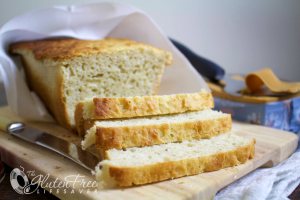 warm and fuzzy joy. I’ve only before had that same pleasure in New Zealand (go figure!). Every other country I’ve lived (including Australia, USA and Norway), most store-bought gluten-free breads require a little more ceremony before it starts resembling a regular loaf, but here, I can enjoy bread that looks normal. In fact, it doesn’t crumble, it doesn’t taste like cardboard, and, like its vacuum-packed counterpart, it stays fresh for a looong time. Great news, right!
warm and fuzzy joy. I’ve only before had that same pleasure in New Zealand (go figure!). Every other country I’ve lived (including Australia, USA and Norway), most store-bought gluten-free breads require a little more ceremony before it starts resembling a regular loaf, but here, I can enjoy bread that looks normal. In fact, it doesn’t crumble, it doesn’t taste like cardboard, and, like its vacuum-packed counterpart, it stays fresh for a looong time. Great news, right!
Shelf-life or shelf-death?
-Hang on a minute. Why is that? Why does store-bought gluten-free bread stay all bouncy and perky longer than an average teenager? Is it because of all that gluten-free goodness? -All the wonderful healthy ingredients keeping mould at bay? No, it’s because it contains more junk than you can shake a stick at, that’s why. So, when I say gluten-free store-bought bread comes at a price, I’m talking about more than that crazy, hold-on-to-your-hat, three-times-the-price-and-half-the-size kinda price. I’m talking about the kinda price you pay with both your wallet AND your health.
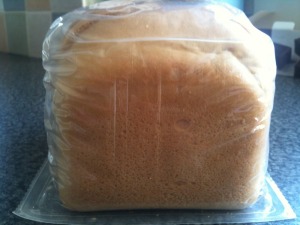
Tempting?
Not to be silly; “regular” gluten bread is no better of course. Preservatives are not exactly a gluten-free phenomenon to say the least. In fact, “regular” bread is for the most part even worse, with all the extra gluten added, bleached grains, colourings and double-strength yeast to boot. -Which is why I’m all for baking your own! Gluten or no gluten; home-baked bread is the only way to save both your wallet AND your body.
I want my gluten-free bread to taste “normal!
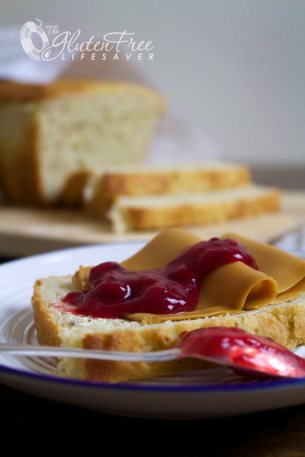
Fresh, warm bread with Norwegian brown cheese and homemade raspberry jam. My fondest treat as a child, joyfully recreated 🙂
Knowing these things, why does that soft and fluffy store-bought English gluten-free bread make me feel all warm and fuzzy inside? Because it tastes nice! It brings back memories of gluten-filled meals with crunchy crusts and soft slices.. in other words; normality. And I think that it is absolutely fantastic that those options are out there now. We need some normality. We need bread that is just as tasty and full of junk as the bread we used to eat before coeliac disease, and I’m not telling you not to the enjoy easy convenience and simple pleasures of normality. -We deserve some of that. Heck, we’ve earned it! -But.. just as we can’t binge on cake, neither should we eat a whole lot of store-bought bread if we can help it. It’s not doing our gut any favors. Besides, what beats fresh-from-the-oven home-baked deliciousness anyway!
Which is why we need a fantastic blow-me-away kinda home-baked bread experience! One that satisfies the same senses, but leaves out the punishment. And for that we need a better-than-great recipe!
Are you sick of messing up your home baked breads?
I’m willing to bet that at this point, your internal voice is saying something like “that’s all well and good, but I honestly can’t take another flat loaf or I’ll go mad”. Not to worry, we’ve all been there. We’ve all felt that eager anticipation mixed with hope, after spending what seemed like hours fighting a sticky paste made from flours we’ve never before heard of. -The excitement as we see it rise in the oven and fill the house with tempting aromas.. only to have our hopes deflated as we cut into a greyish brick with absolutely no crust, other than a solid inch of dehydrated dough which only value can be as a chew toy for the house pet.
Oh, the waste of time and hard-earned cash.
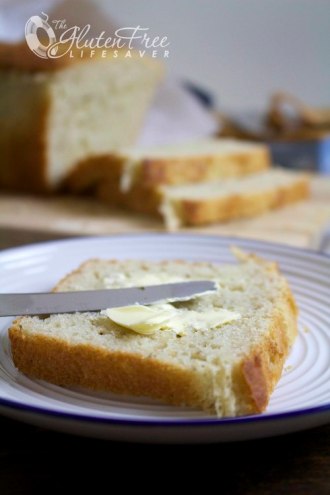 Light and soft gluten-free bread that doesn’t crumble!
Light and soft gluten-free bread that doesn’t crumble!
What you need is the right recipe. That’s really all you need!
This recipe is the best one I have done so far, and it is a joy every time I take a loaf out of the oven. My husband loves it too, and one loaf hardly lasts a day. It requires a bit of precision, but certainly no more than “regular” gluten bread. If you’re used to making your bread solely from ready-mixes, then baking your own from scratch might take a little getting used to -but the satisfaction as you bite into a warm piece of perfect homemade toast, fresh out of the oven, makes it all worth while and then some!
Tip: If you do like ready-mixes, my best tip is to pre-make a big batch of the flour mix, and use it just like you would a store-bought one!
You can easily freeze the loaves, or even the dough, but it tastes really nice fresh. This recipe produces a beautifully “fluffy” bread full of little air bubbles, which give a tall and light result. It doesn’t need toasting when it’s fresh, and it doesn’t dissolve into the much-loathed gluten-free disintegrating mess we all know so well. You’re gonna love it!
God is in the details
Note: before I start rattling off cups and centigrades, I really need to stress that baking is chemistry, and never was that statement more painstakingly true than when applied to gluten-free baking. -You really do need to pay attention to the details of the recipe, perhaps skimming through it and getting things ready, before you get started. No Roadrunner approach, in other words. Take your time, and put some love into it. It isn’t hard, but it is precision work.
Tip: Bake several loaves at once, -or even rolls, and freeze individually or sliced. That way you don’t have to repeat the process very often!
Note: I have incorporated two alternatives for the dry ingredients. This is because not everything is available everywhere. You can choose what works best for you, just make sure you don’t accidentally add both at once! -A good example of mistakes that can be avoided by taking the time to read the recipe up front.
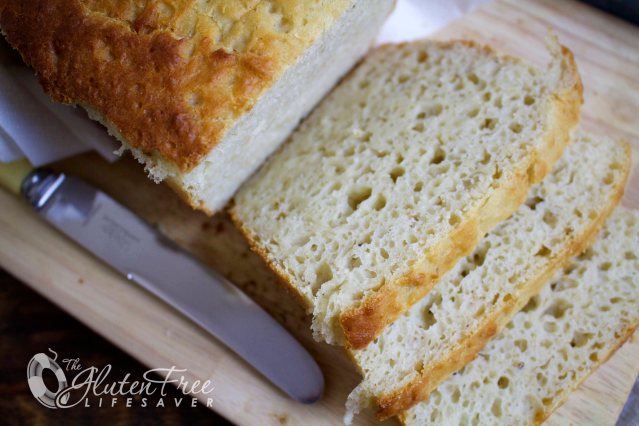
-look at all the bubbles!
You’ll need:
Yeast mix
- 240 ml warm milk (40 degrees celsius/104 Fahrenheit) The temperature is important for the yeast to activate; too cold and nothing happens, too hot and the yeast dies. If you can’t have dairy; soy milk or rice milk will do. Avoid lactose-free milk or goat’s milk for this purpose.
- 2 tbsp dry yeast (I keep mine in the fridge rather than the cupboard to preserve the quality).
- 2 tbsp sugar
-You might not like sugar, but the yeast does. In fact, yeast needs sugar to activate, so don’t leave it out. Especially if you’re not using dairy, as the yeast feeds on the lactose (dairy sugar) in the milk.
Dry ingredients -option 1:
- 600 ml of The Gluten Free Lifesaver’s All-Purpose flour mix
- 60 ml almond meal
- 2,5 tsp xantan gum OR 1 tsp vegan gelatine powder
- 1 tsp gluten-free baking powder
- 1 tbsp sugar
- 1 1/4 tsp salt
Dry ingredients -option 2:
- 420 ml white gluten-free flour mix which contains gluten-free wheat starch (if you don’t want to use wheat starch -I don’t blame you, use my gluten-free flour mix)
- 180 ml brown/fibre flour mix without wheat starch, which contains rice flour, tapioca starch, potato starch, buckwheat and beet fibre.
- 60 ml almond meal
- 60 ml dry milk powder
- 2,5 ts xantan gum OR 1 tsp vegan gelatine
- 1 tsp gluten-free baking powder
- 1 tbsp sugar
- 1 1/4 tsp salt
Wet ingredients:
- 2 tsp white wine or apple cider vinegar
- 2 tbsp neutral oil
- 2 large organic eggs from pastured hens -at room temperature
- 80 ml warm water (40 c/140 f)
Method
- Preheat your oven to 220 c/428 f (200 c/390 f for fan forced)
- Grease and line a large bread pan; remember that the bread needs space to rise without spilling over the edge. A slimmer, taller pan will give you a taller loaf.
- Activating the yeast: Mix the sugar and dry yeast in a bowl, and gently mix in the warm water/milk. Leave the bowl in a warm (not hot!) location, until it has risen to about double or triple its original size. Note: If your yeast mixture doesn’t “grow”, you’ve either used too cold or too hot liquids, or your yeast is “dead”. Start over, because it is imperative that your yeast if full of bubbles!
- Mix all your dry ingredients in a large bowl. Use a whisk to blend well.
- Pour the wet ingredients (hold back the yeast mixture!) into another bowl, and run your mixer on low speed.
- Once mixed, add the activated yeast, and mix very carefully not to “flatten” it and destroy the precious bubbles.

This is how your yeast mix should develop
7. Turn down your mixer to low, and add the dry ingredients about 100 ml at a time. Once it’s all in, turn your mixer up to medium speed. Mix for 1 minute and one minute only!
8. Turn your mixer off and let the dough rest for a minute.
9. Once it has rested, pour it into your bread pan.
10. Cover the bread pan with cling film or a warm, wet towel. A great tip is to put the bowl into a larger one, and cover the larger one instead. This way you don’t risk your bread rising up into the towel and getting disturbed by you tearing it off. Place the bowl in a warm (not hot) spot. I often fill my sink with hot water, place a rack over top and place my bowl on it.
11. Once the dough has doubled in size (about 40 minutes), place it in the oven. Bake for 40 minutes, or till the bread has a golden crust and a hollow sound when you tap the bottom of the pan.
12. When you remove the loaf from the oven you need to let it cool down a bit before you cut into it.
Tip: I like to put a bowl of water in the bottom of the oven, which creates a nice, humid climate for your loaf.
You can store the loaf in a sealed plastic container, or freeze it once it has cooled down completely. I recommend slicing it before you freeze it; it’s very practical for quick defrosts.
I hope you’ll enjoy this wonderful gluten-free bread recipe, and that you fall in love with your own achievements on the home baking arena! It is very satisfying to master your very own bread recipe!
If you have any questions about the recipe I’d be happy to answer them! Just leave a comment below the post.
I am very eager to develop this recipe further, and would love to hear from those of you who have adapted it into other things, like rolls or cinnabuns for example!
 The Gluten Free Lifesaver
The Gluten Free Lifesaver 







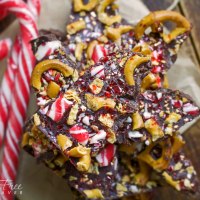

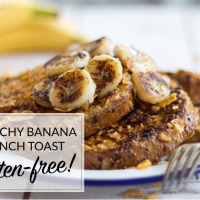
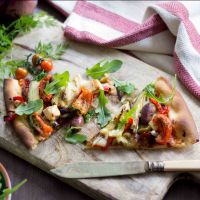
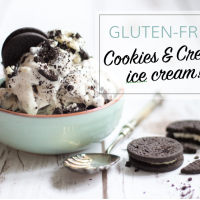
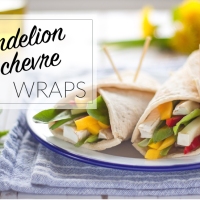


Awesome!
LikeLike
Thanks Sherry! 🙂
LikeLike
Hi Kristine! Thanks for sharing your gf recipes and your story. We live in Germany and 3 of my daughters have celiac. It has been 4 years now. I was wondering if you weigh your ingredients for your recipes also? I was hoping for grams in the measurements… Thanks.
LikeLike
Hi Stephanie, thank you for visiting my blog! I often use weight instead of volume, and always for mixing flour, but some recipes have ingredients that work well with volume, and so I do use both. I also often link to a conversion calculator, and you can also find a conversion chart in the “Tools” section of the blog.
I thank you for your feedback, and I will try to incorporate more options in my recipes!
-Kristine
LikeLike
I’m itching to try it although it looks a little daunting. When you say 600ml of dry ingredients I’m a bit puzzled. Do you mean 600gms – MLS are a liquid measure?
LikeLike
Hi Shelagh! That’s a great question 🙂 I am Scandinavian, and we tend to measure both liquid and dry ingredients in ml, so ml it is. I do my best to add international measurements, but with readers all over the world it can be a bit tricky to get it right for everyone. I’m glad you asked, and that you’re giving the recipe a go! It does make amazing bread 🙂 -Kristine
LikeLike
Hi Kristine, thanks for answering so promptly, however I’m still confused – does that mean I measure the flour in a measuring jug up to the 600ml mark? Having done that the gram weight is approx. 320gms does that sound correct to you? Also, is there a cost to receive your email information? Most other GF bread I have tried turn out like bricks so I’m really looking forward to giving yours a go. Regards from “down under” – Shelagh
LikeLike
Hi again Shelagh, yes that sounds about right. You will get the most accurate results using my flour mix, so with other gf flours there is a slight chance you’ll have to adjust a little. The dough is supposed to be quite moist: not like regular (wheat flour) dough. You should be able to spoon or pour (with a little help from a spatula) it into the bread pan. If you end up having troubles, let me know and I might be able to pinpoint where it went wrong. But I’m sure it will be fine 🙂 There is no charge at all to sign up for my newsletter, and if you sign up using the link in the bread recipe, you’ll get a printable version if it. I hope that helps! Let me k ow how you go 🙂 -Kristine
LikeLike
thank you for all your help Kristine – It’s a cold, miserable weekend here in Australia – seems like a good time to bake some bread.
LikeLike
A great way to make use of a grey day 😊 You are very welcome! I hope it proves a success for you!
LikeLike
Hi Kristine! Just getting back to your recipe and wondering about the dry milk powder… Is it a necessity? What is the purpose? I also question the baking powder? (I hope it works without as I can’t have it)
There are so many recipes out there with so many different combinations of ingredients, and still, to find a recipe that fits everyone in the family is such a task! It used to be so easy… flour, yeast, salt, water. basta! Now we need double the ingredients and have no guarantees .
Sorry for the tirade. Once again on the look out for something that works for our family.
Thanks for your blog and your recipes!
LikeLike
Hi Stephanie! You don’t have to use the milk, but it does help make the bread better. The yeast likes the lactose, and the protein in the milk also helps. You can use soy milk or rice milk instead, as a second best option. Stay away from lactose-free milk or goats milk for the best result. I believe that option is listed in the recipe. The baking powder helps rise the bread. Yeast alone is ok, but because gluten is what usually helps trap the air in the dough when rising, baking powder helps the bread get that extra “lift” when the bread is gluten-free. You can use bicarbonate instead of regular baking powder. You can also leave it out, but with a lot of changes to the recipe I can’t guarantee the result. You will get the very best result if you follow the recipe 🙂 Yes, it is easier to bake with gluten, and we can all get frustrated over all the “complications” of gluten-free baking. But the ingredients that I have listed are the ones that are necessary for this particular recipe, and they are all there for a reason: to make this bread a close to “regular” bread as possible. The reason you are seeing so many different ingredients in various recipes for gluten-free bread, is that just about every gluten-free flour mix is different and will react differently. I recommend taking a look at my post about gluten-free flours to gain an insight into how it all works . You can find that post on this link: http://thankheavens.com.au/2013/01/31/mix-your-own-gluten-free-flour-easy-guide/
I hope that helps clear it up for you!
-Kristine
LikeLike
Hi Kristine!
I have had celiac for 12 years now, diagnosed later in life so unfortunately I know what I am missing as well. 😊 this is my first attempt to make sandwich bread, it is currently in the oven so we will see what happens. But, I was wondering if this recipe could be adapted for a bread maker?
LikeLike
Hi Joe! Nice to hear from you 🙂 I know how you feel; I was diagnosed at 30! I hope the bread was a success. Yes, it should be ok to adapt for bread maker, however, with most bread makers you can’t activate the yeast. You need to add liquids first, then flour and lastly dry yeast. If you have a gluten-free setting on your bread maker then use that. Give it a go, and please do let us know how it went! All the best, Kristine
LikeLike
Hi Kristine, your all purpose flour mix has worked well with a recipe i tried, now for your bread recipe! However, almond meal is not for me with ibs, what could i use instead please?
LikeLike
Hai Sandra, I’m so glad you like the flour mix! Can you have soy flour? If so, try that plus an egg yolk to substitute the almond meal. Otherwise use regular flour mix along with the egg yolk. Hope you enjoy the bread! 😊 -Kristine
LikeLike
I just made this, after getting over the vacuum sealed cardboard bread on offer in Australia. All I can say is yum!! Totally worth the effort.
LikeLike
Aw Mandy I’m so glad to hear that it was a success! 😊 Thanks so much for the feedback!
LikeLike
Hi Mandy, I am also in Australia. Have made the bread once in my Breville Breadmaker. The top a little rocky but texture was good. I am still a little stuck on the measuring to convert to grams also did you use our spoon measurement. I thought my mix was not liquid enough, certainly not pouring with a little spatula help. Would like to try the oven this time to cook the bread. Would really appreciate your input.
LikeLike
Hi Gail, thanks for your feedback! I’m noticing that a few people are having troubles with my European measurements. I’m sorry about that. I wouldn’t try to convert to grams though, but rather cups, as ml is a volume measurement and not weight. By converting to grams you will definitely have some troubles getting it right. Try using a simple ml to cup calculator online. You will find that a lot easier to use 🙂 I am really happy to hear that it worked well in your bread maker! If the mix is little too big for your size breadmaker, then you could try to halve it. Maybe if it doesn’t reach the top of the pan it won’t bake the crust too much? Hope that helps, and if anyone else has experiences to share with Gail then that would be great! 🙂 -Kristine
LikeLike
Thank you Kristine, will try that measurement conversion, will let you know how It turns out. Gail
LikeLike
You’re very welcome 😊 Thanks so much for reading the blog!
LikeLike
Hi….. what changes, if any, would have to be made to this recipe and / or cooking to make this work in a bread maker as opposed to an oven? Many thanks, Dug
LikeLike
Hi Dug! As every bread maker is different, and as I normally bake this bread in an oven, I unfortunately can’t give you an exact answer. My best suggestion is that you look at the bread recipes which came with your bread maker and adapt it from that, however, as a general rule I can say that bread makers often require you to add the liquid first and use dry yeast which you add last. Because of that, you might do best not to proof the yeast before its added. You also need to adjust the size of the loaf to the size of the bread maker. Some bread makers can handle up to 1 kg of flour whilst others only do 4-500 grams. I’m sure this recipe will do just as well in a bread maker as an oven, in fact I’ll give it a go myself to test it! Hope it works out for you, and thanks for reading the blog 😊 -Kristine
LikeLike
Hi Kristine…. Many thanks for reply………. i’ll track my adaptions and let you know how it/they turn out…… i sooooooooo miss white bread…lolol
LikeLike
Awesome! I’d love to hear how you go 😊
LikeLike
Thank you Kristine for a great recipe. I don’t think my husband can go back to shop bought breads anymore!
I used bread maker and came out beautiful. I activated yeast as you suggested then put everything in a machine and used gluten free setting for a medium crust. I use Panasonic, if anyone is interested.
LikeLike
Thanks for that feedback Akiko! I know a lot of people were wondering whether it could be down in a bread maker 😊 -Kristine
LikeLike
Hi, I have made your sandwich bread twice now while it tastes great, mind falls in the middle, you can actually see it happen while it is cooling on the rack. What is the trick to keeping that nice high loaf? Also, my bread is grey in colour, I used “your” flour mix but I’m not sure if my buckwheat is a little dark, I live in Canada maybe some of the ‘flour processing’ could be a little different, I’m not sure. Thanks, Kay
LikeLike
Hi Kay, thanks for your feedback! Gluten-free baking can be a little temperamental from time to time, and two people following the same recipe may get different results because of differences in flours, ingredient temperatures, methods or even the oven they are using. If you keep having this problem, I would firstly try to use a thermometer inserted into the middle of the bread as it bakes. Remove it from the oven when the core reaches about 90-93 degrees celcius. It might be that your bread isn’t entirely finished when you remove it from the oven. If the crust is dark before that time, your oven might be a but warm. Try turning it down a bit. In regards to achieving that “high” loaf; be very particular about the yeasting process, and unlike regular dough, you do not want to knead the dough too long as that destroys precious air bubbles that you need for it to rise. Another option is to bake the bread in a slow cooker. Use the thermometer, set the slow cooker to high, and remove the bread at 90 degrees. About the buckwheat: yes, it could be that the brand you use is a bit different. That might even change the quality of the bread. Perhaps try a different brand one time, and see if it helps? Hope that solves the problem! I’d love to hear how you go 😊 -Kristine
LikeLike
i tried this bread it was a little raw in the middle with eggy smell.the mixure was a little runny is that right?i find when i use use yeast with eggs it gives an ehggy smell.however when i made a loaf without yeast and used sour dough it was nice but did not rise much.dont lknow what to do after a great gf bread for my mother.
LikeLike
Hi Nasree, I am happy to hear from you! The mixture should be moist but not runny. If the bread was raw int he middle it might need more time to bake. Every oven behaves a little bit different, and you will get the most accurate result if you insert a thermometer into the middle of the bread. The bread should be done at about 90-93 degrees celcius. If you don’t have a thermometer, try to tap on the base of the bread and listen for a hollow sound. If the sound isn’t hollow, then it will need to keep baking for a bit.
I hope that helps!
Best regards,
Kristine
LikeLike
Omg just made this didn’t have enough tapioca flour and couldn’t fing sorghum flour so made it up with brown rice flour and potato starch. After many failed attempts this is awesome chewy and soft it is not going to last long. The only thing I would do different would be to split the mixture between 2 tins
LikeLike
Hi Felicity, thanks so much for your feedback! I’m so glad it worked for you in the end 🙂 Great tip that brown rice and potato starch also works! I hope this has become a recipe you’ll use again! Love, Kristine
LikeLike
Please inform me as to why dry ing no 1 is 600 ml dry no 2 is 420 and ur mix is 180 am I reading it wrong? Just want to check it out before I make it. Thanks
LikeLike
Hi Mary, thanks for your question! 180 + 420 makes 600 🙂 They are two different flour mix options. Hope that helps! regards, Kristine
LikeLike
I tried to make this but the yeast didn’t activate, on second reading I think I worked out that there is a typo in recipe. Should it be 104 F instead of 140?
I will be trying again!!
LikeLike
Hi Claire! Yes! You are absolutely right! It’s definitely a typo and should be 104 f. Thanks so much for letting me know, and I’m so sorry for the trouble. I have changed it, and I hope your second attempt works out! -Kristine
LikeLike
Hi Kristine could you tell me what’s in your all-purpose flour mix please. As i have just been diagnosed with coeliac disease at 51 and struggling to gind or make a bread that’s not like a stogie brick and doesn’t make me feel sick . many Lea
LikeLike
Hi Lea! You can find my flour mix and many others on this link: https://thankheavens.com.au/2013/10/14/want-to-mix-your-own-gluten-free-flour-its-easy-use-this-great-guide/ And you can find two great bread recipes on these two links: https://thankheavens.com.au/2015/07/20/the-best-gluten-free-crusty-french-bread-baguette-recipe/ and https://thankheavens.com.au/2015/01/21/the-worlds-best-gluten-free-sandwich-bread-recipe/ I hope that helps 🙂 If you have any questions about the recipes, please leave a comment and I’ll help you! -Kristine
LikeLike
Dry ingredients option 1
“600 ml of The Gluten Free Lifesaver’s All-Purpose flour mix
60 ml almond meal ”
Just wondering are the measurements in grams or in ml? If in ml, what that means?
LikeLike
Hi Tilly, great question! I normally post flour mixes in weight, but on this one I created it using volume, and so it has remained. Ml means mililiter. 1000 ml is 1 liter, so 60 ml is 0,06 liters, and 600 ml is 0,6 liters. I don’t know where you are based, but these are European measurements. 60 ml is 0,253 US cups, and 600 ml is 2,536 US cups. Hope that helps 🙂 -Kristine
LikeLike
Hi Kristine, my son has anaphylaxis to dairy, eggs and wheat and bread is something we love him to have to fill him up (he is only 10). Can you tell me if this recipe can be adapted to go without the egg and if so, what would it be. He recently went overseas to England and had no trouble finding Schar Wholesome White Loaf in the supermarkets which he likes. Currently where I am in Australia there is nowhere that i know of within 1200km of me that sells this bread. I would like to make him something other than the premix stuff I use now. Any help you could offer would be greatly appreciated….Andrew
LikeLike
Hi Andrew, thanks for your question 🙂 You can definitely take the egg out of the recipe and still get a good result. Just add 3 tbsp liquid per medium egg instead. Also, you can replace some of the flour with a protein rich pea flour. That will help. You can also add gluten-free oats or oat flour (ground oats) as this will help the texture of the bread. Oats are not labelled as gluten-free in Australia, but if your son is not coeliac but rather allergic to wheat, you can look for wheat-free oats in supermarkets. An estimated 1 in 5 coeliac’s react to avenin in oats. Personally, I can eat gluten-free oats, and I bought the brand “Free Oats” from Woolies when I lived in Oz.
If your son can have oats, then it provides a great source of nutrition as well as a great flour to bake with that has similar qualities to wheat in terms of performance.
If you’re not sure if your son can have oats the I recommend you consult with his doctor before you introduce it.
I hope that helps! If there’s anything else I can do for you, please let me know!
Regards,
Kristine
LikeLike
Oh wow,
Just made this, and it is so delicious and I did not expect it to be so wheat bread like, and no kneading so kinda easier. I had no sorghum flour so substituted brown rice for the flour mix, worked well. Nice airation, great stretch and eventual tear, just spot on. Ate 1/3 while still warm
LikeLike
Hi! Thanks so much for the feedback, I am so glad you enjoyed the recipe! 🙂 Nothing beats a good loaf, and it’s so nice when you find one you like. I’m glad I could help! -Kristine
LikeLike
Hi Kristine,
Just wondering why you wouldn’t use lactose free milk?
LikeLike
Hi Sam, great question! Because the result depends on the lactose (milk sugar), and so lactose free milk wouldn’t do much in this context. Thanks for asking 😊
LikeLike
There is a sweet gentleman at our church, he is a HARD celiac, I mean, NO, MILK, NO WHEAT FLOUR, NO CHEESES OF ANY KIND(although, have not tried Goats milk), NO CHOCOLATE, NO NUTS. We sometimes have potluck dinners at the church, I try to fix him a few “GOODIES”
But so many recipes have MILK products, I have to use Coconut Milk. (Can you whip coconut milk, for sub. whipping cream?) I have tried to make yeast breads but they turn out with a woodsy taste or dry. Please HELP ME. I would like them to taste a little on the nutty side. I have also noticed that the RICE flours gives things Gluten free tasting a LITTLE on the dirt side.
How about Amaranth flour instead of rice flour
HELP PLEASE!!!!!!
Mary
LikeLike
Hi Mary, how lovely that you are so eager to bake for your friend! Thanks for your question. When a recipe calls for rice flour, I would use just that. Amaranth flour and rice flour have different qualities. Yes, you can whip coconut cream (the thick stuff, not the milk) just as fluffy as regular cream. There are also vegan varieties of cream that can be whipped. To stop a gluten-free bread recipe from going dry, make sure you add more fluids than a regular bread dough. Gluten-free dough is more like a batter than a dough. Also, you can add physillum husks, and you can place a dish with some water in the bottom of your oven when you bake the bread. Can he have eggs? Why not try this amazing carob brownie recipe: https://thankheavens.com.au/2013/09/26/the-worlds-best-carob-brownie/
Hope that helps 🙂 Love from kristine
LikeLike
Hi Kristine, My son is also allergic to egg yolks. Would it be possible to substitute the eggs with some other ingredients, or just use egg whites?
LikeLike
Hi Bobby, Yes you can definitely use just the egg whites. No problem 🙂 -Kristine
LikeLike
This is my go to gluten free bread recipe! And because I make it fortnightly, sometimes weekly I know it pretty much off by heart!
Thank you for sharing, so nice to have bendable, soft & fresh bread in my life again.
I make variations of a seeded bread by adding 1/2cup of mix linseed, pepitas & chia. Also a raisin loaf by adding 2 extra tablespoons of sugar to the dry mixture, plus 2 tablespoons of cinnamon, 1/2 cup of raisins or sultanas. Sometimes I add a bit of chopped up dried fig & apricot too if I’m feeling a bit fancy.
Thanks again.
LikeLike
Dear Hayley, thank you so much for sharing both your opinion of the recipe and these awesome variations! I really appreciate it! 🙂 I will definitely try that raisin loaf idea, and I’m sure a lot of other readers will love it too! Love from Kristine
LikeLike
Hi Kristine,
Your flour mix already has xantan gum in it. Am I supposed to add 2.5 tsp of xantan gum again to the bread recipe?
Marianne
LikeLike
Hi, Marianne! No, if you choose to use my flour mix, then you do not need to add the xantan gum twice. Thanks for pointing out the confusion 🙂 -Kristine
LikeLike
Hello, Thank you so much for posting your bread recipe online. Can it made with a bread machine? I have a very active newborn and don’t have a lot of free time. If I can get a bread machine to make this bread, I’d be grateful.
LikeLike
Hi Jessica! You could try in a good quality bread machine, but because one of the reasons this recipe works so well is the order of how the recipes are added and the proofing of the yeast, it may not come out quite as well. But, worth a shot! Let us know how you go! 🙂 -Kristine
LikeLike
Can this flour be used in other recipes as a substitute for regular flour. Will it make a rue for gravy, scalloped potatoes, mac and cheese, etc. This is a Christmas present for my mom. I want to make her this bread and would like her to be able to eat some of the sides that we’ll have for Christmas dinner. Will the food taste “normal” using this flour?
LikeLike
Hi, Janet! You can definitely use this flour for other food items as well. Gluten-free baked goods tend to have a slightly different texture to “ordinary” baked goods, so you’d have to expect some differences. The result also depends on you following the recipe more diligently than perhaps a gluten recipe allows. With a bit of practice, however, the results will be great and definitely very tasty! Hope your mum enjoyed the bread! – Kristine
LikeLike